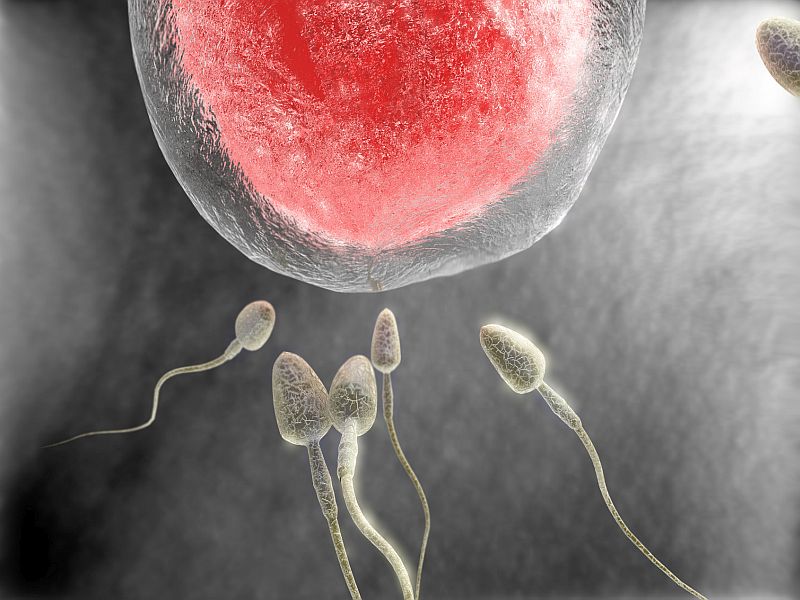Female Anatomy May Play Big Role in Sperm's Success
By Dennis ThompsonHealthDay Reporter

WEDNESDAY, Feb. 13, 2019 (HealthDay News) -- In the race to conception, the female body is set up to separate weak sperm from strong, researchers report.
A woman's reproductive system presents a veritable obstacle course that stress-tests sperm, making sure that only the strongest swimmers have a chance of reaching a woman's egg, according to a new study.
Narrow gate-like passages within the female reproductive tract force competing sperm to barge their way through, ensuring that weak and less viable sperm are left behind, the researchers explained.
"It's survival of the fastest swimmers," said Dr. Harry Fisch, a clinical professor of urology and reproductive medicine at Weill Cornell Medical College in New York City. Fisch was not involved in the study.
"The ones that are swimming properly and … can make it through the openings of the female reproductive system are the ones with the best chance of fertilization," he explained.
This new knowledge will help couples struggling to conceive a baby, either by giving natural conception a boost or by improving the process of in vitro fertilization, reproductive medicine experts said.
Sperm count has been an ongoing focus of reproductive medicine, but doctors haven't been sure which of three main features is most important, Fisch said.
Doctors evaluating sperm look at concentration (the number of sperm), morphology (the shape of the sperm), and motility (the percentage of sperm that are swimming), Fisch said.
To aid conception, doctors first focused on sperm concentration, counting the number of sperm in a man's ejaculate, Fisch said.
"After that, the shape of the sperm was thought to be critical," Fisch said. "The shape of the sperm had to be a certain oval, a certain length and width, no defect. We thought that was even more critical than sperm concentration."
The new study indicates that doctors have not placed enough emphasis on sperm motility, Fisch said.
"We see so many sperm in our practices that don't swim too much. They swim a little bit and we think it's probably fine," Fisch said. "This gives you information that, for natural conception, motility is more important than we thought."
For this study, researchers at Cornell University created a device that replicated the fluid mechanical properties of microscopically narrow junctions inside the female reproductive tract. They call them "strictures."
The investigators found that sperm from both humans and bulls tended to collect at strictures. At that point, fluid mechanics sorts the sperm out, with slower swimming sperm swept back while faster swimmers continue to press forward.
Both human and bull sperm moved in a butterfly-shaped path along the stricture entrance, and only sperm able to achieve a certain speed appear able to maintain a path that would help them continue along the reproductive tract.
"In nature, when you start off in a normal setting of 60 to 100 million sperm trying to achieve fertilization with one egg, millions of years of evolution have fine-tuned a system that seems to give us the most optimal outcomes," said Dr. Natan Bar-Chama, director of the Center of Male Reproductive Health at Reproductive Medicine Associates of New York. He's also an associate professor with the Icahn School of Medicine at Mount Sinai in New York City.
Fisch said that the information gained from this lab experiment could improve lab-assisted reproduction by keeping it as natural as possible.
To give a male partner's sperm a better chance, doctors might inject it farther up into the female reproductive tract, Fisch said. That would provide a short-cut past the strictures, while still providing for some competition between sperm in their quest for the egg.
Doctors also could "wash" the sperm as a means of improving their swimming strength, Fisch noted.
"You take the ejaculate and you remove the fluid around it and put it in different fluid, so the sperm can move better," Fisch said. "That's done every day, but this could lead us to more research into better ways of enhancing sperm movement."
These findings also could improve in vitro fertilization, Bar-Chama added.
Currently, doctors pick any sperm and inject it into an egg, he said. By subjecting the sperm to a rigorous test of the sort used in this experiment, a fertility expert would be able to choose from the strongest sperm.
"When we have these powerful technologies that bypass natural reproduction, we still would like to optimize filtration and selection, and potentially this type of research advances that," Bar-Chama said.
The findings were published Feb. 13 in Science Advances.
This video, supplied by the research team, shows sperms' trajectories as tracked in the study.
More information
The U.S. Office on Women's Health has more about conception and fertility problems.

The news stories provided in Health News and our Health-E News Newsletter are a service of the nationally syndicated HealthDay® news and information company. Stories refer to national trends and breaking health news, and are not necessarily indicative of or always supported by our facility and providers. This information is provided for informational and educational purposes only, and is not intended to be a substitute for medical advice, diagnosis, or treatment.

